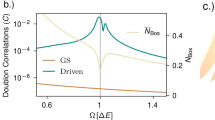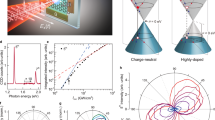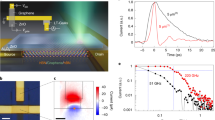Abstract
Light incident upon materials can induce changes in their electrical conductivity, a phenomenon referred to as photoresistance. In semiconductors, the photoresistance is negative, as light-induced promotion of electrons across the bandgap enhances the number of charge carriers participating in transport. In superconductors and normal metals, the photoresistance is positive because of the destruction of the superconducting state and enhanced momentum-relaxing scattering, respectively. Here we report a qualitative deviation from the standard behaviour in doped metallic graphene. We show that Dirac electrons exposed to continuous-wave terahertz (THz) radiation can be thermally decoupled from the lattice, which activates hydrodynamic electron transport. In this regime, the resistance of graphene constrictions experiences a decrease caused by the THz-driven superballistic flow of correlated electrons. We analyse the dependencies of the negative photoresistance on the carrier density, and the radiation power, and show that our superballistic devices operate as sensitive phonon-cooled bolometers and can thus offer, in principle, a picosecond-scale response time. Beyond their fundamental implications, our findings underscore the practicality of electron hydrodynamics in designing ultra-fast THz sensors and electron thermometers.
This is a preview of subscription content, access via your institution
Access options
Access Nature and 54 other Nature Portfolio journals
Get Nature+, our best-value online-access subscription
$32.99 / 30 days
cancel any time
Subscribe to this journal
Receive 12 print issues and online access
$259.00 per year
only $21.58 per issue
Buy this article
- Purchase on SpringerLink
- Instant access to full article PDF
Prices may be subject to local taxes which are calculated during checkout



Similar content being viewed by others
Data availability
The data shown in Figs. 1–3 can be found on Zenodo (https://doi.org/10.5281/zenodo.12952757). The other data that support the findings of this study are available from the corresponding authors upon reasonable request.
References
Aamir, M. A. et al. Ultrasensitive calorimetric measurements of the electronic heat capacity of graphene. Nano Lett. 21, 5330 (2021).
Fong, K. C. et al. Measurement of the electronic thermal conductance channels and heat capacity of graphene at low temperature. Phys. Rev. X 3, 041008 (2013).
Betz, A. C. et al. Hot electron cooling by acoustic phonons in graphene. Phys. Rev. Lett. 109, 056805 (2012).
Viljas, J. K. & Heikkilä, T. T. Electron–phonon heat transfer in monolayer and bilayer graphene. Phys. Rev. B 81, 245404 (2010).
Kubakaddi, S. S. Interaction of massless Dirac electrons with acoustic phonons in graphene at low temperatures. Phys. Rev. B 79, 075417 (2009).
Massicotte, M., Soavi, G., Principi, A. & Tielrooij, K.-J. Interaction of massless Dirac electrons with acoustic phonons in graphene at low temperatures. Nanoscale 13, 8376 (2021).
Koppens, F. H. L. et al. Photodetectors based on graphene, other two-dimensional materials and hybrid systems. Nat. Nanotechnol. 9, 780 (2014).
Bonaccorso, F., Sun, Z., Hasan, T. & Ferrari, A. C. Graphene photonics and optoelectronics. Nat. Photon. 4, 611 (2010).
Mittendorff, M., Winnerl, S. & Murphy, T. E. 2D THz optoelectronics. Adv. Opt. Mater. 9, 2001500 (2021).
Wallbank, J. R. et al. Excess resistivity in graphene superlattices caused by umklapp electron–electron scattering. Nat. Phys. 15, 32 (2019).
Shilov, A. L. et al. High-mobility compensated semimetals, orbital magnetization, and umklapp scattering in bilayer graphene moire superlattices. ACS Nano 18, 11769–11777 (2024).
Efetov, D. K. & Kim, P. Controlling electron–phonon interactions in graphene at ultrahigh carrier densities. Phys. Rev. Lett. 105, 256805 (2010).
Kumaravadivel, P. et al. Strong magnetophonon oscillations in extra-large graphene. Nat. Commun. 10, 3334 (2019).
Wang, L. et al. One-dimensional electrical contact to a two-dimensional material. Science 342, 614 (2013).
Lee, G.-H. et al. Graphene-based Josephson junction microwave bolometer. Nature 586, 42 (2020).
Jung, M., Rickhaus, P., Zihlmann, S., Makk, P. & Schönenberger, C. Microwave photodetection in an ultraclean suspended bilayer graphene p–n junction. Nano Lett. 16, 6988 (2016).
Bandurin, D. A. et al. Dual origin of room temperature sub-terahertz photoresponse in graphene field effect transistors. Appl. Phys. Lett. 112, 141101 (2018).
Castilla, S. et al. Fast and sensitive terahertz detection using an antenna-integrated graphene pn junction. Nano Lett. 19, 2765 (2019).
Titova, E. et al. Ultralow-noise terahertz detection by p–n junctions in gapped bilayer graphene. ACS Nano 17, 8223 (2023).
Han, Q. et al. Highly sensitive hot electron bolometer based on disordered graphene. Sci. Rep. 3, 3533 (2013).
Efetov, D. K. et al. Fast thermal relaxation in cavity-coupled graphene bolometers with a Johnson noise read-out. Nat. Nanotechnol. 13, 797 (2018).
El Fatimy, A. et al. Epitaxial graphene quantum dots for high-performance terahertz bolometers. Nat. Nanotechnol. 11, 335 (2016).
Riccardi, E. et al. Ultrasensitive photoresponse of graphene quantum dots in the Coulomb blockade regime to THz radiation. Nano Lett. 20, 5408 (2020).
Gurzhi, R. N. Hydrodynamic effects in solids at low temperature. Sov. Phys. Uspekhi 11, 255 (1968).
de Jong, M. J. M. & Molenkamp, L. W. Hydrodynamic electron flow in high-mobility wires. Phys. Rev. B 51, 13389 (1995).
Lucas, A. & Fong, K. C. Hydrodynamics of electrons in graphene. J. Phys. Condens. Matter 30, 053001 (2018).
Varnavides, G., Yacoby, A., Felser, C. & Narang, P. Charge transport and hydrodynamics in materials. Nat. Rev. Mater. 8, 726 (2023).
Crossno, J. et al. Observation of the Dirac fluid and the breakdown of the Wiedemann–Franz law in graphene. Science 351, 1058 (2016).
Bandurin, D. A. et al. Negative local resistance caused by viscous electron backflow in graphene. Science 351, 1055 (2016).
Bandurin, D. A. et al. Fluidity onset in graphene. Nat. Commun. 9, 4533 (2018).
Levitov, L. & Falkovich, G. Electron viscosity, current vortices and negative nonlocal resistance in graphene. Nat. Phys. 12, 672 (2016).
Berdyugin, A. I. et al. Measuring Hall viscosity of graphene’s electron fluid. Science 364, 162 (2019).
Sulpizio, J. A. et al. Visualizing Poiseuille flow of hydrodynamic electrons. Nature 576, 75 (2019).
Ku, M. J. H. et al. Imaging viscous flow of the Dirac fluid in graphene. Nature 583, 537 (2020).
Fritz, L., Schmalian, J., Müller, M. & Sachdev, S. Quantum critical transport in clean graphene. Phys. Rev. B 78, 085416 (2008).
Müller, M., Schmalian, J. & Fritz, L. Graphene: a nearly perfect fluid. Phys. Rev. Lett. 103, 025301 (2009).
Gallagher, P. et al. Quantum-critical conductivity of the Dirac fluid in graphene. Science 364, 158 (2019).
Nam, Y., Ki, D.-K., Soler-Delgado, D. & Morpurgo, A. F. Electron–hole collision limited transport in charge-neutral bilayer graphene. Nat. Phys. 13, 1207 (2017).
Tan, C. et al. Dissipation-enabled hydrodynamic conductivity in a tunable bandgap semiconductor. Sci. Adv. 8, eabi8481 (2022).
Bandurin, D. A. et al. Interlayer electron–hole friction in tunable twisted bilayer graphene semimetal. Phys. Rev. Lett. 129, 206802 (2022).
Block, A. et al. Observation of giant and tunable thermal diffusivity of a Dirac fluid at room temperature. Nat. Nanotechnol. 16, 1195 (2021).
Dyakonov, M. & Shur, M. Shallow water analogy for a ballistic field effect transistor: new mechanism of plasma wave generation by dc current. Phys. Rev. Lett. 71, 2465 (1993).
Zhao, W. et al. Observation of hydrodynamic plasmons and energy waves in graphene. Nature 614, 688 (2023).
Ruiz, D. B. et al. Experimental signatures of the transition from acoustic plasmon to electronic sound in graphene. Sci. Adv. 9, eadi0415 (2023).
Guo, H., Ilseven, E., Falkovich, G. & Levitov, L. S. Higher-than-ballistic conduction of viscous electron flows. Proc. Natl Acad. Sci. USA 114, 3068 (2017).
Krishna Kumar, R. et al. Superballistic flow of viscous electron fluid through graphene constrictions. Nat. Phys. 13, 1182 (2017).
Waissman, J. et al. Electronic thermal transport measurement in low-dimensional materials with graphene non-local noise thermometry. Nat. Nanotechnol. 17, 166 (2022).
Purdie, D. G. et al. Cleaning interfaces in layered materials heterostructures. Nat. Commun. 9, 5387 (2018).
Sharvin, Y. V. On the possible method for studying Fermi surfaces. Zh. Eksperim. i Teor. Fiz. 48, 984 (1965).
Terrés, B. et al. Size quantization of Dirac fermions in graphene constrictions. Nat. Commun. 7, 11528 (2016).
Principi, A., Vignale, G., Carrega, M. & Polini, M. Bulk and shear viscosities of the two-dimensional electron liquid in a doped graphene sheet. Phys. Rev. B 93, 125410 (2016).
Mylnikov, D. A. et al. Terahertz photoconductivity in bilayer graphene transistors: evidence for tunneling at gate-induced junctions. Nano Lett. 23, 220 (2023).
Ludwig, F. et al. Terahertz detection with graphene FETs: photothermoelectric and resistive self-mixing contributions to the detector response. ACS Appl. Electron. Mater. 6, 2197 (2024).
Shein, K. et al. Fundamental limits of few-layer NbSe2 microbolometers at terahertz frequencies. Nano Lett. 24, 2282 (2024).
Graham, M. W., Shi, S.-F., Ralph, D. C., Park, J. & McEuen, P. L. Photocurrent measurements of supercollision cooling in graphene. Nat. Phys. 9, 103 (2013).
Messelot, S. et al. Tamm cavity in the terahertz spectral range. ACS Photon. 7, 2906 (2020).
Berdyugin, A. I. et al. Out-of-equilibrium criticalities in graphene superlattices. Science 375, 430 (2022).
Acknowledgements
The research at NUS is supported by Singapore Ministry of Education Tier 2 grant award T2EP50123-0020 (photoresponse measurements) and Academic Research Fund Tier 1 (sample fabrication). M.A.K. acknowledges the support of RSF grant 22-72-00084. O.P., M.T., A.L.S., M.L. and M.A.K. were supported by internal funding programme from the Center for Neurophysics and Neuromorphic Technologies. K.S.N. is grateful to the Ministry of Education, Singapore (Research Centre of Excellence award to the Institute for Functional Intelligent Materials, I-FIM, project number EDUNC-33-18-279-V12) and to the Royal Society (UK, grant number RSRP R 190000) for support. D.A.S. acknowledges the support from RSF grant 21-79-20225. I.G. was supported by RSF (project number 23-72-00014). A.P. acknowledges support from the European Commission under the EU Horizon 2020 MSCA-RISE-2019 programme (project 873028 HYDROTRONICS) and from the Leverhulme Trust under the grant agreements RPG-2019-363 and RPG-2023-253. We acknowledge fruitful discussions with E. Nikulin on the heat equation.
Author information
Authors and Affiliations
Contributions
D.A.B. conceived the experiment as well as designed and supervised the project. M.K., A.L.S. and A.K. performed transport and photoresistance measurements. Y.Y., M.A.K., Y.W., O.P., M.T. and D.V. fabricated devices. K.S., I.G., G.N.G. and K.S.N. provided experimental support. T.T. and K.W. grew hBN crystals. T.P., D.A.S., S.A. and A.P. provided theory support. M.L. performed the electromagnetic simulation of the antenna performance. M.K., A.L.S. and D.A.B. wrote the paper with input from all authors. All authors participated in the discussion.
Corresponding author
Ethics declarations
Competing interests
The authors declare no competing interests.
Peer review
Peer review information
Nature Nanotechnology thanks Mengkun Liu and the other, anonymous, reviewer(s) for their contribution to the peer review of this work.
Additional information
Publisher’s note Springer Nature remains neutral with regard to jurisdictional claims in published maps and institutional affiliations.
Extended data
Extended Data Fig. 1 Further examples of viscous photoconductivity.
a, Differential resistance, \(\Delta {R}_{{{\rm{pc}}}}=d{V}_{{{\rm{pc}}}}/dI{| }_{I = {I}_{{{\rm{dc}}}}}-d{V}_{{{\rm{pc}}}}/dI{| }_{I = 0}\), across the PC, induced by the DC current, Idc, as a function of DC power PDC at different n, relative to its zero-bias value. b, Examples of the PC photoresistance ΔRpc vs P0 measured at different n. The positive slope of ΔRpc vs P0 at PDC > 1 μW and n = 0.5 × 1012 cm−2 suggests the presence of an additional mechanism contributing to resistance that we currently attribute to the proximity to the out-of-equilibrium Schwinger regime57. c, Calibration curves P0 vs PDC obtained by relating the resistance drop from (a) and (b). W = 0.31μm. All measurements are done at T = 2K. In the main text, Pabs ≡ PDC.
Supplementary information
Supplementary Information
Supplementary Figs. 1–8 and discussion.
Rights and permissions
Springer Nature or its licensor (e.g. a society or other partner) holds exclusive rights to this article under a publishing agreement with the author(s) or other rightsholder(s); author self-archiving of the accepted manuscript version of this article is solely governed by the terms of such publishing agreement and applicable law.
About this article
Cite this article
Kravtsov, M., Shilov, A.L., Yang, Y. et al. Viscous terahertz photoconductivity of hydrodynamic electrons in graphene. Nat. Nanotechnol. 20, 51–56 (2025). https://doi.org/10.1038/s41565-024-01795-y
Received:
Accepted:
Published:
Issue date:
DOI: https://doi.org/10.1038/s41565-024-01795-y



